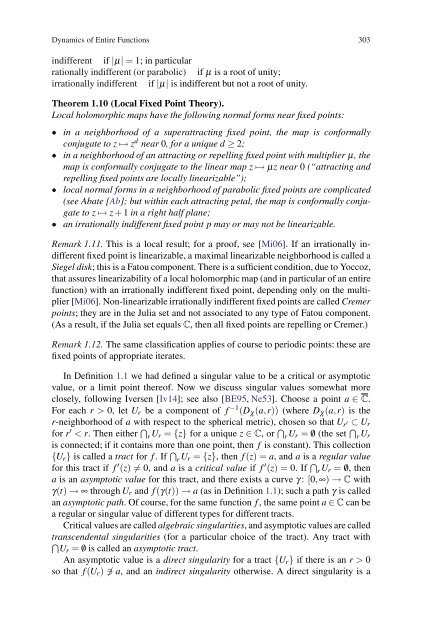Discrete Holomorphic Local Dynamical Systems
Discrete Holomorphic Local Dynamical Systems
Discrete Holomorphic Local Dynamical Systems
Create successful ePaper yourself
Turn your PDF publications into a flip-book with our unique Google optimized e-Paper software.
Dynamics of Entire Functions 303<br />
indifferent if |μ| = 1; in particular<br />
rationally indifferent (or parabolic) if μ is a root of unity;<br />
irrationally indifferent if |μ| is indifferent but not a root of unity.<br />
Theorem 1.10 (<strong>Local</strong> Fixed Point Theory).<br />
<strong>Local</strong> holomorphic maps have the following normal forms near fixed points:<br />
• in a neighborhood of a superattracting fixed point, the map is conformally<br />
conjugate to z ↦→ zd near 0, for a unique d ≥ 2;<br />
• in a neighborhood of an attracting or repelling fixed point with multiplier μ,the<br />
map is conformally conjugate to the linear map z ↦→ μz near0 (“attracting and<br />
repelling fixed points are locally linearizable”);<br />
• local normal forms in a neighborhood of parabolic fixed points are complicated<br />
(see Abate [Ab]; but within each attracting petal, the map is conformally conjugate<br />
to z ↦→ z + 1 in a right half plane;<br />
• an irrationally indifferent fixed point p may or may not be linearizable.<br />
Remark 1.11. This is a local result; for a proof, see [Mi06]. If an irrationally indifferent<br />
fixed point is linearizable, a maximal linearizable neighborhood is called a<br />
Siegel disk; this is a Fatou component. There is a sufficient condition, due to Yoccoz,<br />
that assures linearizability of a local holomorphic map (and in particular of an entire<br />
function) with an irrationally indifferent fixed point, depending only on the multiplier<br />
[Mi06]. Non-linearizable irrationally indifferent fixed points are called Cremer<br />
points; they are in the Julia set and not associated to any type of Fatou component.<br />
(As a result, if the Julia set equals C, then all fixed points are repelling or Cremer.)<br />
Remark 1.12. The same classification applies of course to periodic points: these are<br />
fixed points of appropriate iterates.<br />
In Definition 1.1 we had defined a singular value to be a critical or asymptotic<br />
value, or a limit point thereof. Now we discuss singular values somewhat more<br />
closely, following Iversen [Iv14]; see also [BE95, Ne53]. Choose a point a ∈ C.<br />
For each r > 0, let Ur be a component of f −1 (Dχ(a,r)) (where Dχ(a,r) is the<br />
r-neighborhood of a with respect to the spherical metric), chosen so that Ur ′ ⊂ Ur<br />
for r ′ < r. Then either �<br />
r Ur = {z} for a unique z ∈ C, or �<br />
r Ur = /0 (theset �<br />
r Ur<br />
is connected; if it contains more than one point, then f is constant). This collection<br />
{Ur} is called a tract for f .If �<br />
r Ur = {z}, thenf (z)=a, andais a regular value<br />
for this tract if f ′ (z) �= 0, and a is a critical value if f ′ (z) =0. If �<br />
r Ur = /0, then<br />
a is an asymptotic value for this tract, and there exists a curve γ : [0,∞) → C with<br />
γ(t) → ∞ through Ur and f (γ(t)) → a (as in Definition 1.1); such a path γ is called<br />
an asymptotic path. Of course, for the same function f , the same point a ∈ C can be<br />
a regular or singular value of different types for different tracts.<br />
Critical values are called algebraic singularities, and asymptotic values are called<br />
transcendental singularities (for a particular choice of the tract). Any tract with<br />
�<br />
Ur = /0iscalledanasymptotic tract.<br />
An asymptotic value is a direct singularity for a tract {Ur} if there is an r > 0<br />
so that f (Ur) �∋ a, andanindirect singularity otherwise. A direct singularity is a



